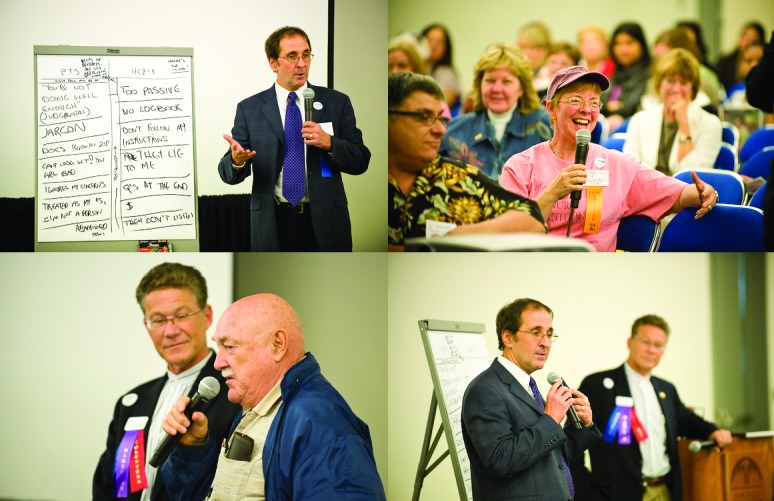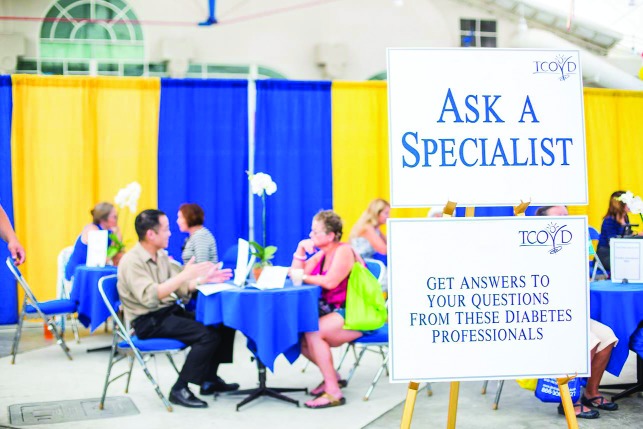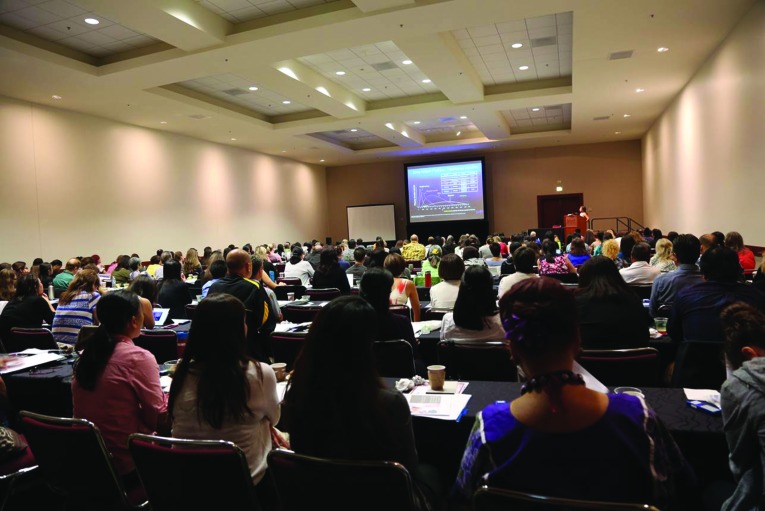Introduction: Our Diabetes Toolbox Has Grown, But A1C in the United States Has Remained Flat
The gold-standard goal of diabetes management has been to achieve meaningful and sustained glycemic control to reduce the risk of long-term complications. Unfortunately, results from the National Health and Nutrition Examination Survey indicate that only ∼50% of adults with diabetes in the United States, mostly with type 2 diabetes, are achieving an A1C <7.0%, and this percentage has not changed over the past decade (1).
In addition, the proportion of patients meeting individualized targets has declined according to the American Diabetes Association and American Association of Clinical Endocrinologists, and the overall proportion of patients in very poor control, defined as an A1C >9%, has actually increased (2,3).
The Healthcare Effectiveness Data and Information Set results, with data from >1,000 health plans covering >171 million lives, are even more striking, demonstrating that, in 2014, ∼40% of commercially insured health maintenance organization patients and 30% of government insured patients achieved an A1C <7.0, again reflecting no change in the past 10 years (4).
All of this has occurred despite the introduction of >40 new treatment options for people with type 2 diabetes. This fact is quite shocking and difficult to understand, especially given that our armamentarium of effective and safe type 2 medications has expanded over the same time period to include dipeptidyl peptidase 4 (DPP-4) inhibitors, sodium glucose cotransporter 2 inhibitors, designer insulins, inhaled insulin, and glucagon-like peptide 1 (GLP-1) receptor agonists.
Reduced Sense of Urgency in People With Type 2 Diabetes
Although there may be many reasons why these new treatment options haven’t made a dent in the glycemic control of our patients with type 2 diabetes during these past 10 years, I feel strongly that the basic and primary issue is a lack of patient education, motivation, and activation.
Type 2 diabetes is a silent condition with few or no symptoms caused by poor glucose, blood pressure, and lipid control. Thus, there is little or no sense of urgency, and this is a key issue. People with type 2 diabetes are asked to take a handful of pills, give themselves injections, and prick their fingers to measure their blood glucose several times a day. However, they do not feel any different whether they follow or don’t follow the orders we, their health care providers (HCPs), give them.
In addition, there is a negative attitude and actual fear of prescription drugs, most of which are also extremely costly. Don’t you love those television commercials that are repeatedly played throughout the day and night from lawyers who are planning class action lawsuits against pharmaceutical companies? This type of information just adds to unfounded fears. Meanwhile, many people with type 2 diabetes search for a miracle cure on TV, on the Internet, or in vitamin stores and are grabbing on to the unproven or outright false claims that accompany such products. The sale of over-the-counter supplements that are not regulated by the U.S. Food and Drug Administration and have no proven benefits is a multibillion-dollar industry.
Large Health Care Administrative Claims Databases Tell Us That Our Patients Are Not Taking Their Medication
One consistent theme that is revealed when large health care databases profile our patients with type 2 diabetes is that they are not taking their medications. Adherence is shockingly low. The most common method of measuring medication adherence is by “proportion of days covered” based on pharmacy refill records. Patients are labeled as “poorly adherent” if that proportion is <80% of the time (5).
Of course, there is no guarantee that medications picked up from the pharmacy are actually taken. Additionally, patients cannot be labeled poorly adherent if they never fill their prescriptions in the first place, which is incredibly common, occurring up to 30% of the time in some studies. These two issues contribute to an underestimation of the problem of poor adherence.
The data on injectable agents such as basal insulin and GLP-1 receptor agonists show that adherence with these medications is typically only 25–30% after 1 year of treatment (6). Data also consistently show that, for oral medications used for treating type 2 diabetes, adherence is ∼50% after 1 year, even for DPP-4 inhibitors, which are dosed once daily and have practically no side effects (6). To put it bluntly, people with type 2 diabetes are not taking their medications, including those for other medical problems such as hypertension and dyslipidemia. The large body of evidential data that powerfully links poor adherence to the complications of diabetes, including coronary heart disease, hospitalizations, absenteeism, presenteeism (working while sick), disability claims, and other costs to the health care system is nothing short of staggering.
Patient Education, Motivation, and Self-Advocacy
Diabetes control, both in the United States and around the world, is still inadequate for the majority of people living with this chronic condition. However, there have been numerous advances in the field of diabetes that can potentially wipe out or greatly reduce the human suffering and costs associated with diabetes. Why is it that advances in the diabetes medical field have far outpaced care at the community level? I believe one of the most important missing links is that patient education and motivation have been seriously lacking or even nonexistent.
The people who are living with this condition need to be the most knowledgeable members of their health care teams and to take the main responsibility for their own health. People with diabetes (PWD) need to be their own best advocates and to work in collaboration with their HCPs. They must learn what needs to be done to live a long, healthy, and productive life with their diabetes and then go out and do everything they can to achieve that goal. Being smart and being persistent are central themes of Taking Control Of Your Diabetes (TCOYD).
About TCOYD
TCOYD is a 501(c)(3) not-for-profit charitable educational organization that I founded in 1995. At that time, the Diabetes Control and Complications Trial had conclusively proven that control of blood glucose could prevent or significantly reduce the serious complications associated with poorly controlled diabetes (7). However, despite this information being widely circulated in medical communities across the United States, the manner in which diabetes was being managed at the clinical level was not changing. For that reason, I made the decision to take the crucial message about the importance of glucose control directly to the people who it affected the most—the people who were living with diabetes. Now in its 23rd year, the mission of TCOYD remains the same:
Guided by the belief that every person with diabetes has the right to live a healthy, happy, and productive life, Taking Control Of Your Diabetes educates and motivates people with diabetes to take a more active role in their condition and provides innovative and integrative continuing diabetes education to medical professionals caring for people with diabetes.
TCOYD promotes this mission in a variety of ways and through several information portals. These include our flagship national series of face-to-face conferences and health fairs (185 completed as of this writing); our award-winning YouTube video series The Edelman Report (available from https://www.youtube.com/playlist?list=PLC0D808A1CAEFBE8B); our monthly digital e-newsletter with all content residing on our blog (blog.tcoyd.org); the book Taking Control Of Your Diabetes (8); our content-rich, mobile-optimized website (www.tcoyd.org); and our Facebook Live series Curbside Consults (available from www.facebook.com/tcoyd), all of which are intended to keep PWD engaged and proactively caring for their own health. Finally, for the past 12 years, we have offered a unique series of continuing medical education (CME) programs offering HCPs cutting-edge information on advances in diabetes care, as well as a greatly improved understanding of what it’s like to live with diabetes on a day-to-day basis.
Spreading the Word
In my many years of experience as a diabetes specialist, I have never met a PWD who did not want to live a long and healthy life. I can’t tell you how many times I have heard an HCP state that, “Diabetic patients are noncompliant” and “They just do not care about their own health.” I believe such PWD have either never been properly educated and motivated to take control of their diabetes or their HCPs just do not understand the barriers these people face in their efforts to control this 24/7 condition.
Conferences and Health Fairs
TCOYD was founded on the core principle that, when it comes to educating, motivating, and instilling a concept of self-advocacy, nothing replaces the empowering experience of face-to-face interactions. This is why our ongoing national series of conferences remains the foundation for how TCOYD fulfills its mission.
TCOYD conferences are held in major convention centers in cities across the United States. In the past 22 years, we have touched the lives of hundreds of thousands of PWD and their loved ones in significant ways. This comment from one TCOYD conference attendee is representative of the sentiments so many people express after participating in a TCOYD event:
I was feeling pretty burned out with my diabetes when I came to the TCOYD conference. Being around other people with diabetes and listening to so many informative and inspiring speakers really made a huge difference in my own level of knowledge and positivity. Whenever you are in my area again, I will do whatever it takes to attend.
TCOYD conferences are a full 8-hour day, normally held on a Saturday, and consist of general sessions for all attendees (Figure 1), as well as specialized tracks for type 1 and type 2 diabetes covering topics that are important for each of these quite different forms of diabetes. The type 2 diabetes track focuses on realistic lifestyle modifications and cardiovascular risk reduction and directly addresses the issues relating to adherence that are so prevalent in those with type 2 diabetes. The type 1 diabetes track focuses more on technology, such as insulin pumps, continuous glucose monitoring systems, and the artificial pancreas, as well as other topics of concern for people with type 1 diabetes, including family planning, associated autoimmune conditions such as celiac disease and hypothyroidism, and emotional and behavioral issues.
FIGURE 1.
A TCOYD conference general session.
Throughout the day, participants meet and chat with each another (Figure 2). Becoming acquainted with others who are living with the same condition is so important in creating a community and a sense of belonging; it helps PWD who participate understand that they are not alone in dealing with their diabetes. During the afternoon, participants are given the opportunity to meet one-on-one with a variety of medical specialists, including doctors, dietitians, pharmacists, and certified diabetes educators (Figure 3) and to participate in small-group physical activities such as yoga, Tai Chi and Zumba classes. An extensive, interactive health fair offering appropriate, patient-oriented information (Figure 4) and a closing general session with an inspirational speaker round out the day. Participants leave feeling knowledgeable, hopeful, and motivated to more effectively manage their diabetes.
FIGURE 2.
Participants having lunch at a TCOYD conference.
FIGURE 3.
One-on-one consultation between a diabetes specialist and a PWD at a TCOYD conference.
FIGURE 4.
The health fair at a TCOYD conference.
Through the years, we have learned that the keys to successfully educating and motivating large numbers of people in a group setting include having a faculty of diabetes experts who can effectively speak to a lay audience, have an upbeat attitude, and infuse humor into their presentations. We are firm believers that the use of humor improves information retention, and the thousands of comments we have received from participants confirm that they agree. Up-to-date information is presented in a positive and understandable manner to inspire and activate PWD to assign a higher priority to taking care of their diabetes. We also focus on educating the family members and loved ones who are actually caregivers and associates in the care and feeding of PWD. These family members and loved ones are an unrecognized but extremely important piece of the diabetes care puzzle.
Certain ethnic groups, including African Americans, Pacific Islanders, Native Americans, and Latinos, are hit especially hard by type 2 diabetes. A key to successfully educating people in these groups is to provide information that is appropriate and tailored to their personal and cultural background, beliefs, and heritage. At TCOYD, we seek out diabetes specialists of the same ethnic background as our audiences to create a stronger bond between presenters and participants.
TCOYD conferences change lives by empowering PWD and their loved ones to be on the diabetes offensive. We have conducted numerous validated questionnaires and other studies to document not only statistically significant improvements in participants’ attitude, confidence, and knowledge regarding their diabetes, but also indices of personal self-advocacy and activation in their own health care (9–11). Photos and videos from conferences, along with detailed information about program content, are available on the TCOYD website.
CME Programs
TCOYD has taken on a challenge that, to my knowledge, has not been successfully met anywhere else in the world. Educating physicians about the most up-to-date treatment strategies in diabetes management is a difficult and sometimes slow process, but one of the biggest challenges is actually improving HCPs’ attitudes toward their patients who are struggling with diabetes to establish a more empathetic, trusting atmosphere with more open, two-way communication. TCOYD has taken on this challenge through Making the Connection: Improving Clinical Care and Adherence for Patients with Diabetes (MTC), our innovative series of CME programs now in its second decade.
I feel strongly that if HCPs really knew what it is like (both physically and emotionally) to have diabetes, their level of empathy and genuine understanding would greatly increase. In turn, this would strengthen communication between HCPs and patients and diminish the common experience of HCPs brow-beating patients and inappropriately labeling them as “noncompliant.” PWD often experience guilt and embarrassment regarding their difficulties with treatment adherence and may not be able to admit these perceived shortcomings to HCPs unless the patient-provider relationship is strong and communication is open. Likewise, we have discovered that PWD also need to better understand the day-to-day administrative difficulties HCPs deal with, including the strict time constraints they face. Again, strong relationships and open communication facilitate this understanding.
The MTC CME series is specifically designed to bring together the educational needs of both clinicians and PWD to break down barriers by improving communication and understanding between providers and their patients, ultimately improving long-term patient outcomes. This program also enhances clinicians’ appreciation of many previously unrealized concerns and barriers that affect patients’ adherence to their prescribed medical regimen.
MTC programs are held in tandem with the TCOYD conferences, typically at large convention centers around the country. For part of the day, HCPs in attendance receive cutting-edge CME-accredited lectures from diabetes experts (Figure 5). During other parts of the day, they join PWD for portions of the TCOYD patient conferences. Together, HCPs and PWD hear a discussion about the emotional and behavioral barriers commonly associated with diabetes self-management. HCPs also have lunch with PWD and hear the conference keynote address, which is always given by a motivational speaker who is living well with diabetes.
FIGURE 5.
An MTC general session.
During the afternoon, all of the HCPs attending the MTC program also participate in a combined workshop with some of the PWD attending the TCOYD conference who have selected this joint workshop from a list of concurrent sessions (Figure 6). This combined workshop goes by different titles at different conferences, but my two favorites are “Diabetes Police and Diabetes Criminals” and “Good Doctor, Bad Patient and Bad Doctor, Good Patient.” This workshop is co-led by a psychologist specializing in diabetes (most often my good friend and colleague at the University of California, San Diego, Dr. Bill Polonsky) and myself. It is an interactive and enlightening hour in which both HCPs and PWD can express their thoughts and feelings about provider-patient relationships and attain a better understanding of the frustrations faced by both groups.
FIGURE 6.

Scenes from MTC, a TCOYD CME series.
The professionals complete their MTC experience by discussing all that they observed and learned during the day, not just from the lectures but also, and most importantly, from PWD. They come away with a new appreciation of what PWD must deal with every day of their lives.
More than 25,000 HCPs have attended MTC to date, and these are just a few quotes from their post-conference evaluations:
I cannot imagine a better way to earn [continuing education units] and also be inspired to improve my communication skills with my patients who have diabetes.
I am excited to break through some barriers of care and empower my patients. I’ve learned it is never too late for patients to take control of their diabetes.
From now on, I will be more empathetic and try to help my patients not feel guilty or at fault for having this condition.
I will make a greater effort to establish trust with patients and families; I will discuss their preferences for treating to goal and make those preferences a priority.
[I will] listen, listen, listen to my patients and hear their needs and expectations for treatment.
TCOYD does an over-the-top job of providing for and meeting the needs of both professionals and patients. They are the only organization I know of that provides this kind of opportunity and does it so engagingly and comprehensively. Thank you!
Our published outcome studies demonstrate several areas in which HCPs have changed their attitudes and practice habits (12,13).
In program evaluations, HCPs were asked to list the professional changes they intended to make as a result of participating in the MTC CME activity. The most common answers over the past several years included:
Communicate information more clearly to patients
Improve listening skills
Empower patients
Discuss patients’ emotional needs more
Address patients’ needs before visit demands
Understand the psychology of denial
Spend more time addressing barriers to medication adherence
Listen to patients for a longer period of time
Work more at helping patients with knowing what to do with blood glucose numbers
Encourage patients to tell their stories
Improve/change approach to patient teaching
Communicate more openly with patients; ask about side effects
HCPs were then asked, “How will you address barriers to implement patient change in knowledge and behavior?” The most common answers over the past several years included:
Communicate/listen better
Better understanding of patient barriers
Motivational interviewing
Identify barriers and try to help patients overcome them
Recognize that it might take time for patients to accept change
Ask family members how to address issues
More information about MTC CME programs can be found on the TCOYD website.
Our Continued Challenge
The vision of TCOYD is for all PWD and their loved ones to have full access to proper education and therapy to allow for the prevention, early detection, and aggressive management of diabetes and its complications. This vision statement is our future challenge. TCOYD conferences do touch the lives of the many people in a profound way. However, the total number of participants nationwide is only a fraction of the people in this country who are living with diabetes and need help.
Although our reach is expanding with an enlarged digital footprint, face-to-face diabetes education and motivation must be seriously recognized by our health care industry as an essential part of an effective treatment strategy. Effective diabetes education programs must be carefully developed and offered to all PWD and their loved ones. The educational programs that exist around the country take various forms that can have a great impact.
We have shown that a single day of education can be highly effective, but the education provided must be informative, practical, and adaptable to a wide range of ethnic groups and individual needs. Most importantly, this education must be presented in an upbeat manner, with a humorous undertone, and it must focus on enabling people to become engaged and activated in their own health and well-being. Just having the information is not enough. Becoming activated in one’s own health is the ultimate key to successful blood glucose control over time. There are no shortcuts; very few individuals will turn their diabetes control around from poor to good by downloading a certain smartphone app. However, once PWD are truly activated in their own health, such digital diabetes management programs may be good extenders to help them maintain their motivation over the long term.
Finally, I hope that readers have found some useful information in this article regarding why many of our patients may be having a difficult time with their diabetes. As I said before, I have never met a PWD who did not want to live a long and healthy life. And I know that the vast majority of HCPs who are working hard in the trenches went into the field of medicine to help people live long and healthy lives. Building trust and improving two-way communication between patients and providers are the most powerful factors in improving diabetes care in this country.
Acknowledgments
The author thanks Sandy Bourdette, emeritus executive director of TCOYD, and the entire TCOYD team (Michelle Feinstein, Erik Berg, Collin Stephens, Jennifer Braidwood, Michelle Day, Jill Yapo, Robyn Sembera, Lynne Scharf, Megan Cornelius, and Sarah Severance) for their hard work and dedication. The author also thanks Drs. Jeremy Pettus, Tricia Santos, and Bill Polonsky for their patient education talents and participation at TCOYD events.
Duality of Interest
S.V.E. is the founder and director of the non-for-profit charitable educational organization Taking Control Of Your Diabetes. No other potential conflicts of interest relevant to this article were reported.
References
- 1.Ali MK, Bullard KM, Saaddine JB, Cowie CC, Imperatore G, Gregg EW. Achievement of goals in U.S. diabetes care, 1999–2010. N Engl J Med 2013;368:1613–1624 [DOI] [PubMed] [Google Scholar]
- 2.Inzucchi SE, Bergenstal RM, Buse JB, et al. ; American Diabetes Association (ADA) and the European Association for the Study of Diabetes (EASD). Management of hyperglycemia in type 2 diabetes: a patient-centered approach: position statement of the American Diabetes Association (ADA) and the European Association for the Study of Diabetes (EASD). Diabetes Care 2012;35:1364–1379 [DOI] [PMC free article] [PubMed] [Google Scholar]
- 3.Garber AJ, Abrahamson MJ, Barzilay JI, et al. ; American Association of Clinical Endocrinologists (AACE); American College of Endocrinology (ACE). Consensus statement by the American Association of Clinical Endocrinologists and American College of Endocrinology on the comprehensive type 2 diabetes management algorithm: 2016 executive summary. Endocr Pract 2016;22:84–113 [DOI] [PubMed] [Google Scholar]
- 4.National Committee for Quality Assurance The state of health care quality report, 2015. Available from http://www.ncqa.org/ReportCards/HealthPlans/StateofHealthCareQuality.aspx. Accessed 5 July 2016
- 5.Edelman SV, Polonsky WH. Type 2 diabetes in the real world: the elusive nature of glycemic control. Diabetes Care. Epub ahead of print on 11 August 2017 (DOI: 10.2337/dc16–1974) [DOI] [PubMed]
- 6.Carls GS, Tuttle E, Tan R-D, et al. . Understanding the gap between efficacy in randomized controlled trials and effectiveness in real-world use of GLP-1RA and DPP4 therapies in patients with type 2 diabetes. Diabetes Care. Epub ahead of print on 11 August 2017 (DOI: 10.2337/dc16–2725) [DOI] [PubMed]
- 7.DCCT Research Group The effect of intensive treatment of diabetes on the development and progression of long-term complications in insulin-dependent diabetes mellitus. N Engl J Med 1993;329:977–986 [DOI] [PubMed] [Google Scholar]
- 8.Edelman SV and Friends . Taking Control Of Your Diabetes. 5th ed. West Islip, N.Y., Professional Communications; In press (print and digital) [Google Scholar]
- 9.Stremel J, Bourdette SL, Edelman SV. Increase of health and self-care knowledge in people with diabetes and their significant others after attending an intensive one-day educational conference. Diabetes 2008;57(Suppl. 1):2355-PO [Google Scholar]
- 10.Bergenstal RM, Johnson Anderson RL, Edelman SV, Kendall DM. Impact of a one-day diabetes education program on glycemic control. Diabetes 2005;54(Suppl. 2):935P [Google Scholar]
- 11.Edelman SV, Polonsky WG, Beh G. Changes in self-care behavior and improved glycemic control in people with diabetes after attending an intensive education and motivational conference. Diabetes 2005;54(Suppl. 2):299-OR [Google Scholar]
- 12.Edelman SV, Williams M, Polonsky W. Making the connection between patient and health care professional (HCP): an innovative approach towards improving diabetes care. Diabetes 2012;61(Suppl. 1):806-P [Google Scholar]
- 13.Edelman SV. Impacting diabetes care at the community level: making the connection between patient and provider. Diabetes Spectr 2010;23:202–206 [Google Scholar]







